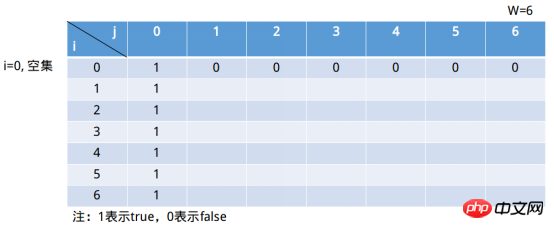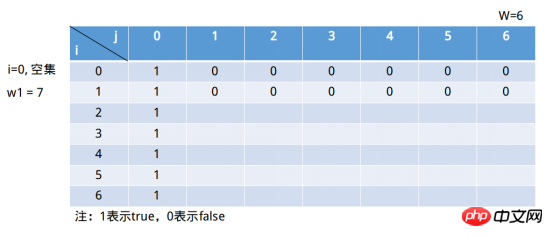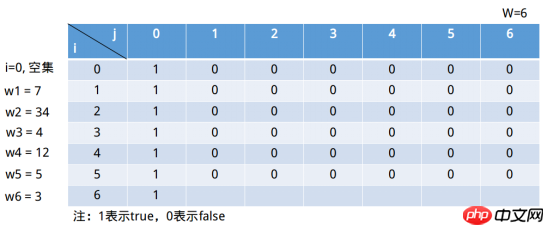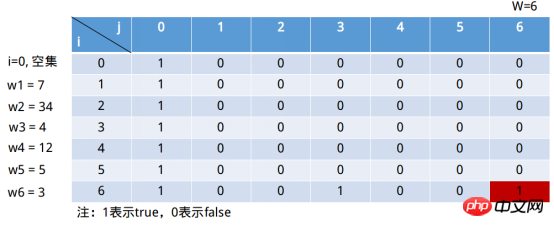
Note: Because the study of "subsets and problems" is not in-depth enough, this article may have unclear descriptions or errors in explaining the dynamic programming recursion formula. If you find any, I hope you can Don’t hesitate to teach me.
The subset sum problem can be described as follows: Given n positive integers W=(w1, w2, …, wn) and the positive integer M are required to find such A subsetI⊆{1, 2, 3, ..., n},so that∑wi=M,i∈I[1] . Take an example to give a popular explanation of the subset sum problem: Set W=(1, 2, 3, 4, 5), given a positive integer M =5, whether there is a subset I of W such that the subset ## The sum of the elements in #I is equal to M. In this example, there is obviously a subset I=(2, 3).
Problem definition: Positive integer setS=(w1, w2, w3, …, wn), given a positive Integer W, i in s[i, j] represents # A subset of ##S, j represents the sum of the subset i. If the sum of elements S of a certain set i#j=M, That is, the problem has a solution. Example: S=(7, 34, 4, 12, 5, 3)
,W=6, whether there is a subset of S, the sum of its elements is equal to W. There are also many solutions to this problem. In this article, we use the idea of dynamic programming to solve it, so we need to derive a recursive formula. We continuously divide the set S
into small sets. This is the first step ofdynamic programming: defining the sub-problem . The smallest set of set S is the empty set. Of course, the empty set does not exist and the sum of its elements is equal to W. Of course, if## In the case of #j=0, the empty set is eligible.
The columns of this table represent the sum of the elements in the set. It can only reach the element W at most. It is of course meaningless if it is greater than W. . As long as 1 appears in the j=6 column, the solution to the problem is obtained. The row represents a subset composed of the first i (including i) elements (this sentence may be a bit doubtful, isn’t this Can’t scan everything? Read on). i=0 represents the empty set.
When we define j=6, the empty set situation is true. Then when j=0, this is true for any subset sum (the empty set is their subset). So the form continues to populate as shown below.

These are actually the third step of dynamic programming: defining the initial state. The second step of state planning is to define state transition rules, that is, the recursive relationship between states.
The i in s[i, j] represents the first i Subset (includes i). In fact, we divide it into two parts from here:
1) Excluding the first i# of the ith element ## subset, that is, s[i - 1, j];
2) Includes thei The first i subset of elements. It is easier to understand the
1) situation. The sum of the first i - 1 set elements is equal to j, then the sum of the subset elements of the first i set elements is equal to j.
What is difficult to understand is the 2) situation. One thing that can be made clear about the second situation is that the i in s[i, X] is certain, and the key is j, jHow to define it at this time? Using "Special value method" in mathematics, take the example set(3, 34, 9), whether there is a sum of elements of a given subset equal to 37, at this time i=2 (subset is (3, 34)), j = 37, at this time “Includes the first i subset of the i element”This kind In the case, s[2, 37] => s[2, 37 - 34] = s[2, 3], subset (3 , 34) Of course there is a subset whose sum of elements is equal to 3. Then if j = 36, s[2, 36] => s[2, 36 - 34] = s[2, 2], the subset (3, 34) obviously does not exist and the sum of its subset elements is equal to 2. What about j = 1, s[2, 1] => s[2, 1 - 34] = s[2, -32],j - wi < 0, at this time s[2, 1] => s[2 - 1, 1] = s[1, 1], subset (3) obviously does not exist and the sum of its subset elements is equal to 1.
In summary, the recursive formula is as follows:

Before implementing this algorithm in code, first fill in the above through the recursive formula matrix.
①i = 1, The subset at this time is (7), j = 1, j ∉ (∅), selection situation2) => s[0, 1] || s[1, -6] (i = 0 represents the empty set). Obviously s[1, 1] = 0.
②i = 1, The subset at this time is (7), j = 2, j ∉ (∅), selection situation2) => s[0, 2] || s[1, -5](i = 0 represents the empty set). Obviously s[1, 2] = 0.
……
⑥i = 1, at this time the subset is (7), j = 6, j ∉ (∅), selection situation 2) => s[0, 6] || s[1 , -1] (i = 0 represents the empty set). Obviously s[1, 6] = 0.

The final filling is as shown below:

Continue to fill in the final One line:
①i = 6, The subset at this time is(7, 34, 4, 12, 5, 3),j = 1, j ∉ (7, 34, 4, 12, 5), selection situation 2) => ; s[5, 1] || s[6, -2] (i = 0 represents the empty set). Obviously s[6, 1] = 0.
②i = 6, The subset at this time is (7, 34, 4, 12, 5, 3), j = 2, j ∉ (7, 34, 4, 12, 5), selection situation 2) => s[5, 1] || s[6, -1] (i = 0 represents the empty set). Obviously s[6, 2] = 0.
③i = 6, The subset at this time is (7, 34, 4, 12, 5, 3), j = 3, j ∉ (7, 34, 4, 12, 5), selection situation 2) => s[5, 1] | | s[6, 0]. Obviously s[6, 3] = 1.
...
⑥i = 6, The subset at this time is(7, 34, 4, 12, 5, 3), j = 6, j ∉ (7, 34, 4, 12, 5), selection situation2) => s[5, 6] || s[6, 3]. Obviously s[6, 6] = 1.

Java
## 1 package com.algorithm.dynamicprogramming; 2 3 import java.util.Arrays; 4 5 /** 6 * 子集和问题 7 * Created by yulinfeng on 7/2/17. 8 */ 9 public class SubsetSumProblem {10 11 public static void main(String[] srgs) {12 int[] sets = {7, 34, 4, 12, 5, 3};13 int sum = 87;14 boolean isExistSubSet = subsetSumProblem(sets, sum);15 System.out.println("集合" + Arrays.toString(sets) + "是否存在子集的和等于" + sum + ":" + isExistSubSet);16 }17 18 private static boolean subsetSumProblem(int[] sets, int sum) {19 int row = sets.length + 1;20 int col = sum + 1;21 int[][] solutionMatrix = new int[row][col];22 solutionMatrix[0][0] = 1;23 24 /**25 * 0 1 2 3 4 5 626 * 0 |1|0|0|0|0|0|0|27 * 1 |x|x|x|x|x|x|x|28 * 2 |x|x|x|x|x|x|x|29 * 3 |x|x|x|x|x|x|x|30 * 3 |x|x|x|x|x|x|x|31 * 4 |x|x|x|x|x|x|x|32 * 5 |x|x|x|x|x|x|x|33 * 6 |x|x|x|x|x|x|x|34 */35 for (int i = 1; i < col; i++) {36 solutionMatrix[0][i] = 0;37 }38 /**39 * 初始状态40 * 0 1 2 3 4 5 641 * 0 |1|0|0|0|0|0|0|42 * 1 |1|0|x|x|x|x|x|43 * 2 |x|x|x|x|x|x|x|44 * 3 |x|x|x|x|x|x|x|45 * 3 |x|x|x|x|x|x|x|46 * 4 |x|x|x|x|x|x|x|47 * 5 |x|x|x|x|x|x|x|48 * 6 |1|0|0|x|x|x|x|49 * [i][0] = 1,按行填充50 */51 for (int i = 1; i < row; i++) {52 solutionMatrix[i][0] = 1;53 for (int j = 1; j < col; j++) {54 solutionMatrix[i][j] = solutionMatrix[i - 1][j];55 56 if (solutionMatrix[i][j] == 1) {57 solutionMatrix[i][j] = solutionMatrix[i][j];58 } else if ( j - sets[i - 1] >= 0 && solutionMatrix[i][j - sets[i - 1]] == 1) {59 solutionMatrix[i][j] = solutionMatrix[i][j - sets[i - 1]];60 } else {61 solutionMatrix[i][j] = 0;62 }63 64 if (j == col - 1 && solutionMatrix[i][j] == 1) {65 return true;66 }67 }68 }69 70 return false;71 }72 }Python3
1 def subset_sum_problem(sets, sum): 2 row = len(sets) + 1 3 col = sum + 1 4 solutionMatrix = [[0 for col in range(col)] for row in range(row)] 5 solutionMatrix[0][0] = 1 6 for i in range(1, col): 7 solutionMatrix[0][i] = 0 8 9 for j in range(1, row):10 solutionMatrix[j][0] = 111 for k in range(1, col):12 solutionMatrix[j][k] = solutionMatrix[j - 1][k]13 if solutionMatrix[j][k] == 1:14 solutionMatrix[j][k] = solutionMatrix[j][k]15 elif (k - sets[j - 1] >= 0) and (solutionMatrix[j][k - sets[j - 1]] == 1):16 solutionMatrix[j][k] = solutionMatrix[j][k - sets[j - 1]]17 else:18 solutionMatrix[j][k] = 019 if k == col - 1 and solutionMatrix[j][k] == 1:20 return True21 22 return False23 24 sets = [7, 34, 4, 12, 5, 3]25 num = 626 is_exist = subset_sum_problem(sets, num)27 print(is_exist)
The above is the detailed content of Detailed examples of subset sum problems. For more information, please follow other related articles on the PHP Chinese website!




